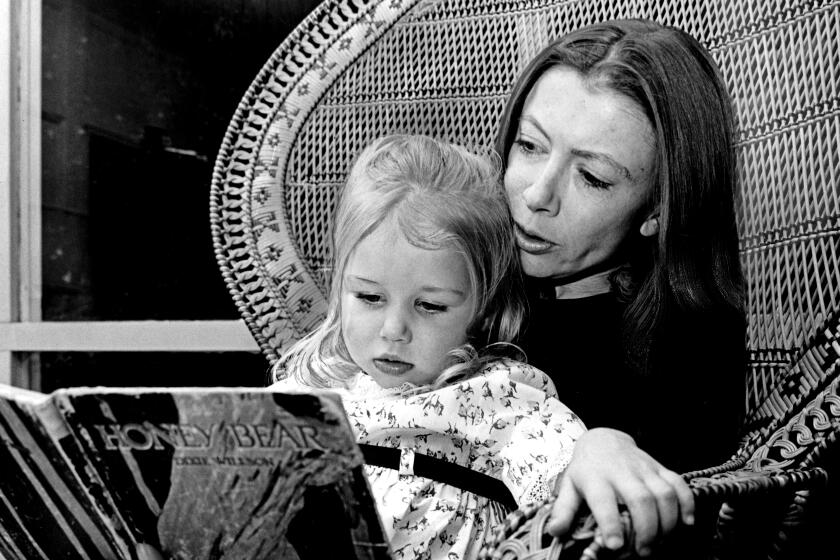BOOK REVIEW: FICTION : Some Satire, a Bit of Mystery, a Dash of Philosophy : DANCE, DANCE, DANCE <i> by Haruki Murakami</i> , T<i> ranslated from the Japanese by Alfred Birnbaum</i> ; Kodansha, $22, 393 pages
- Share via
This Japanese novel is like a boxcar rumbling all alone down the tracks. It’s a big, bright boxcar, loaded with good stuff--mystery, mysticism, sex and rock ‘n’ roll--but we can’t see the engine that has to be pulling it, or the caboose that has to be trailing behind.
In fact, “Dance, Dance, Dance” is a sequel to Haruki Murakami’s 1982 novel “Wild Sheep Chase.” The rather slow beginning of the new story recapitulates the ending of the earlier one. A major character in “Wild Sheep Chase”--the Sheep Man--lives on as a kind of ghost in a shadowy, atavistic world that lies beneath the “advanced capitalism” of modern Japan.
In “Dance, Dance, Dance,” the nameless narrator of both books has become a 34-year-old free-lance writer who “shovels cultural snow” diligently but without passion. Divorced, recovering from a nervous breakdown, unable to connect emotionally with other people, he is drawn back to Japan’s northernmost island, Hokkaido, by dreams in which a woman--perhaps Kiki, the call girl who left him in the seedy Dolphin Hotel, where the Sheep Man used to live--is crying for him.
The hotel is gone, replaced by a posh new Dolphin, but a magical pocket of the Sheep Man’s world still exists. The narrator steps out of an elevator into darkness; a hallway leads him to a candle-lit room where a musty figure in sheepskins tells him: “You gotta dance. As long as the music plays. . . . Your feet stop, you get stuck. . . . Dance so everyone’s impressed.”
The Sheep Man, it seems, is now the narrator’s guardian angel, a cosmic switchboard who can “connect you to what you want.” But the fact that the narrator can see the Sheep Man is a sign of how much he has already lost, of his exhaustion, his closeness to spiritual death.
A young woman who works for the hotel stumbles into the same darkness and hears the shuffle of the Sheep Man’s slippers. A psychic 13-year-old girl whose mother, a brilliant but self-absorbed photographer, has mislaid her at the hotel sees the image of the Sheep Man in the narrator’s mind. These two are his first connections.
Others follow. Back in Tokyo, the narrator runs into a junior high school classmate, Gotanda, now a B-movie star. Gotanda introduces him to another call girl, Mei, who knew Kiki. Then Mei is murdered, with the narrator’s business card in her wallet as the only clue. The hack-novelist father of the 13-year-old, Yuki, hires the narrator as her companion and, as a hedge against statutory rape, buys him a third call girl, who disappears just like the first two.
As for Yuki’s jet-set mother, she has a boyfriend, a one-armed American poet--and when the narrator, on another visit to the shadow world, finds six skeletons sitting on couches in a vacant Honolulu office building, one skeleton has an arm missing.
Dizzy? Yet this is an extremely accessible novel for American readers, thanks to Murakami’s colloquial, wisecracking style, ably translated by Alfred Birnbaum. Murakami’s narrator may be a misfit, but he is a keen observer of the slick, corrupt, image-conscious, expense-account society of the ‘80s. The realistic parts of the novel are fast-moving and funny--no small achievement, considering that the narrator often does little more than eat, drink, brood and listen to his favorite oldies.
“Dance, Dance, Dance” successfully mixes genres--the philosophical quest, the topical satire, the whodunit. Murakami’s characters, from kids to cops, are vividly drawn, no matter how unlikely the situations they encounter. The narrative voice--increasingly sure of itself as the speaker’s mental health improves and he begins to take ethical stands and become capable of love--pulls like a diesel.
Midway through, we have no idea what’s going to happen next, yet we have confidence that a storyteller as good as Murakami will answer all our questions. In fact--surprise!--he doesn’t. Loose ends dangle from the novel like a boxcar’s rear coupling--a sign that it may be linked to yet another Sheep Man story, the conclusion of a trilogy, a caboose so far clickety-clacking only in the author’s mind.
More to Read
Sign up for our Book Club newsletter
Get the latest news, events and more from the Los Angeles Times Book Club, and help us get L.A. reading and talking.
You may occasionally receive promotional content from the Los Angeles Times.










